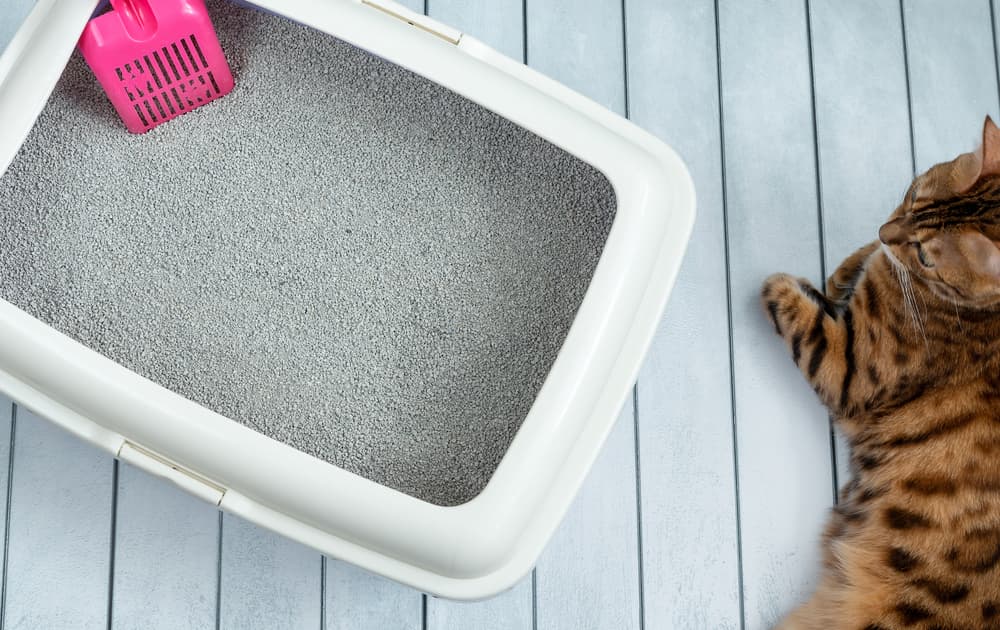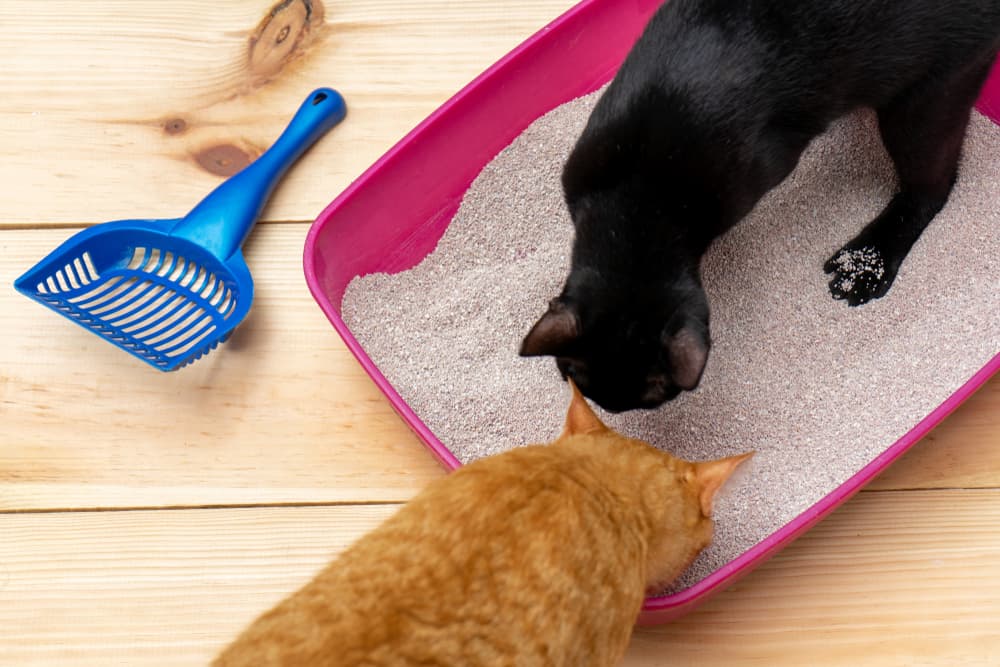8 Types of Cat Litter: A Complete Guide

Cats instinctively bury their waste, which makes it simple to introduce house cats to litter boxes. Most cats are happy to go to the bathroom in their litter box, as long as you provide a good spot to set up their box (many cats prefer privacy), use a litter that your cat likes, and keep the box clean.
As a general rule, you should have at least one litter box per cat in your household, plus one extra. The boxes should be spaced out in different areas of your house rather than grouped together so cats have privacy to use them. Solid waste should be scooped daily, and the litter box should be thoroughly cleaned once a week.
The type of cat litter you use is paramount—cats might not use their litter box if they don’t like the litter inside. Take a stroll down the cat litter aisle of any pet store and you will find a sea of cat litters to choose from, including litters made from many different substances, such as clay or paper, scented and unscented cat litters, and special formulations. For households with more than one cat, there are even multi-cat litters.
With so many options, it can be hard to know the best type of cat litter for your kitty. Read on to learn all about the different types of cat litter, including materials, textures, and scents, plus get helpful tips and advice.
Cat Litter 101: An Overview

All featured products are chosen at the discretion of the Great Pet Care editorial team and do not reflect a direct endorsement by the author.
When choosing a type of cat litter, it’s helpful to understand the following key features:
Clumping vs Non-Clumping
One of the biggest considerations is whether a litter is clumping or non-clumping. Clumping cat litter, which is usually made of clay materials, clumps together when wet, allowing you to scoop urine from the box as well as solid waste. With daily scooping, clumping clay cat litter lasts longer than non-clumping litter. Non-clumping litters made from clay, silica, paper, wood, and other materials quickly become saturated by urine, so you have to dump and clean the entire box more frequently.
According to Emily Swiniarski, DVM, medical director of the Anti-Cruelty Society in Chicago, Illinois, kittens younger than 4 months old should start with non-clumping litter. “Very young kittens taste everything, which could include cat litter,” she says. “Clumping litter could clump inside of kittens’ tummies, and could create a blockage.”
Scented vs Unscented
Scented cat litter helps control odors in the litter box. Although humans might appreciate a scented cat litter, many cats dislike strong perfumes in their litter box and prefer an unscented product. If you want to give scented litter a try, look for one with a light scent so as not to overwhelm sensitive kitty noses.
Weight
Some cat litters weigh more than others. Heavy cat litter can pose a problem for people with mobility or health issues because the weight makes it difficult to buy, carry, fill the litter box, and dispose of the litter. Luckily, there are plenty of lightweight cat litters to choose from in both clumping and non-clumping varieties, some weighing up to half as much as traditional cat litter. Lightweight clumping cat litters are very porous, giving them an extra soft feel that most cats love. Litters made from alternative materials like soy, hemp, and silica crystals are also lightweight.
Dust Level
Many cat owners worry about litter dust affecting their cat’s airways. Dr. Swiniarski says you don’t need to stress too much about litter dust, especially if you choose a low-dust cat litter. “Dust from cat litter doesn’t stay in the air long, and most rooms are large enough or have enough airflow that this is not a long-term concern,” she says. “Cats naturally dig, so the best way to prevent dust is pick a litter that is designed to limit it.”
Tracking
Most cats prefer fine-textured litters, but these tend to stick to a cat’s paws and scatter outside the litter box. If you’re hoping to cut down on the mess, many products, even soft clumping litters, are designed to be low-tracking. Naturally low-tracking cat litters include pelleted litters, like those made of paper or wood.
8 Types of Cat Litter

Cat litter is made from different substances. Most cat owners are familiar with traditional clay cat litter, but you can also buy litters made from alternative materials like corn, wheat, grass, and coconut husks.
“These [alternative material] litters are no better for cats than standard litter, but they could be better for the environment,” Dr. Swiniarski says. “In the very rare cases of cats that like to eat [traditional] litter, these alternative materials would be necessary.”
Some common types of cat litter available include:
Clay
The longest-used type of cat litter, clay cat litter is the most popular and generally the most affordable. Clay cat litter can be clumping or non-clumping, and comes in many formulas, including low-dust, low-tracking, multi-cat, lightweight, and unscented.
Crystal/Silica
Made from silica gel, crystal cat litters are non-clumping but they absorb urine and trap odors. Some crystal litters are rough-textured, which cats might not like, but others are designed to be ultra-soft. This type of litter is very lightweight.
Paper
Cat litter made from paper pellets does not clump but it’s very absorbent. Many brands use recycled paper to make this type of litter. Paper litter is naturally low-tracking, but not all cats like the texture of pelleted litters.
Wood/Pine
Wood-based cat litters may be clumping (soft) or non-clumping (pellets). Pelleted wood litter is similar to paper litter but is made from wood shavings, such as pine. Wood/pine cat litters are very absorbent and have a pleasant, natural smell.
Wheat
Made from wheat, this type of cat litter is soft and clumps for easy cleanup.
Grass
This clumping litter is made from grass but has a soft texture like sand.
Walnut
This soft, clumping litter is made from natural walnut shells.
Corn
Cat litter made from corn kernels or corn cobs clumps for easy cleanup and is flushable.
How to Choose Cat Litter: Other Considerations

In general, most cats like a soft, unscented cat litter, but individual cats will have specific preferences. If you have multiple cats, look for litter formulated for multi-cat households, which often contains extra odor-control ingredients. If you or your cats prefer low or unscented products, look for a litter that uses other odor-fighting technologies, such as activated charcoal.
You might need to do a little trial and error to find a litter that makes both you and your cat happy. If you want to switch your cat’s litter, offer two types in different litter boxes to see which one your cat prefers.
Another method for switching your cat’s litter is to gradually mix the old litter with the new litter in increasing ratios over one week. Do this in a new litter box, while also keeping your cat’s old box with the original litter so it still has your cat’s familiar scent.
“If your cat stops using the changing litter box, you had better not make the switch!” Dr. Swiniarski says. “If your cat continues to use both litter boxes with the same frequency as before, gradually change the second box as well.”
If you are finding pee and poop outside the litter box, it’s possible that you are not cleaning the box frequently enough. Make sure you’re scooping solid waste and clumps at least once a day (more often if you can), and changing all the litter and cleaning the box once a week.
“Many cats will pee or poop immediately next to the litter box if they do not like the cleanliness or type of cat litter,” Dr. Swiniarski says. “Some cats will desperately try to use the litter box while touching the litter as little as possible, crouching on the very edge of the box with only two paws in the litter.”
Underlying medical problems can also cause a cat to go to the bathroom outside the litter box, so talk to your veterinarian to rule out any potential health concerns.
If you’re keeping the box very clean, your cat has a clean bill of health, and they still won’t use the litter box, the problem could be that your cat doesn’t like the litter you’re using. In this case, try introducing a new litter using one of the methods described above. Once you find a litter you know your cat loves, stick to it! Cats are creatures of habit with very specific preferences—the less you change things in their lives, the happier they will be.









